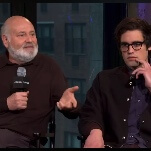After some forays into girl-group pop, Parton found her home on the country charts in the mid-’60s with the hits “Dumb Blonde,” which insisted she was anything but, and “Something Fishy.” The latter, like most of the hits from Parton’s golden age, came from her own pen, yet the years to come found her playing sidekick. In a Faustian bargain, Parton signed on as Porter Wagoner’s sidekick on his highly rated syndicated show. In return, she got a chance for her telegenic personality to make her a household name in country-loving homes—and she got a partner with whom she shared an incredible chemistry. Her career also got another set of hands on the steering wheel. The pair parted, less-than-amicably, in 1974.
Yet while previously unthinkable crossover success awaited Parton after the breakup, the bulk of Dolly comes from the professionally tumultuous, creatively astounding period from the mid-’60s through the Wagoner split. Whether singing love songs, cheating songs, or two-person versions of the country gothic tales that made Wagoner’s solo career, Wagoner and Parton delivered one classic duet after another, squeezing a film’s worth of drama into the span of a 45. On her own, Parton performed as if she had something to prove, singing stories rooted in her Tennessee upbringing, if not her own life. Ominous key changes usher in tragedy and hope comes in whispers, as good girls go bad, strong women lament a world seemingly against them, and the poor make something out of nothing with God’s help. Parton sings the stories of each with forceful conviction, a vulnerable vibrato, and a gripping commitment to the moment. (Fans of the truly odd will want to seek out “Evening Shade,” the story of an orphanage revolt.)
Set free, Parton found even greater success, but it came at a creative cost. The measured sentiment of “Jeannie’s Afraid Of The Dark” and “Coat Of Many Colors” gave way to maudlin heartstring-tuggers like “Me And Little Andy.” Parton also started to spend more time chasing trends than setting them, working with chart-proven songwriters as she let her own pen rest. That isn’t to say that Parton’s work from the mid-’70s on is bad, and Dolly’s later discs deliver the best of it. But if all else were to fade—the theme parks, the movie roles, the charming talk-show appearances, the pop crossovers, even the unmistakable look—the work that made Parton a star would be legacy enough.























![HBO teases new Euphoria, Larry David, and much more in 2026 sizzle reel [Updated]](https://img.pastemagazine.com/wp-content/avuploads/2025/12/12100344/MixCollage-12-Dec-2025-09-56-AM-9137.jpg)

















